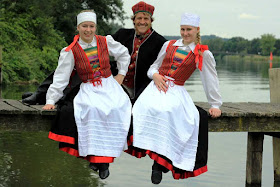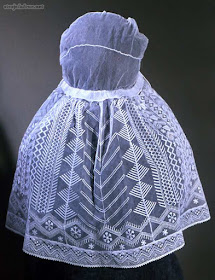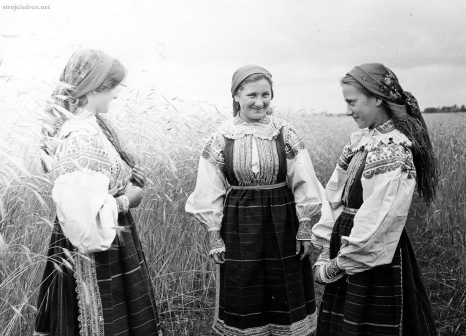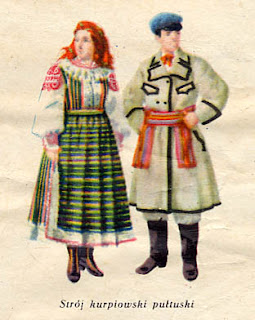Hello all,
Today I feel like I am stepping into a minefield by talking about Pomerania.
https://en.wikipedia.org/wiki/Pomeranians_(Slavic_tribe)
The history of Pomerania is quite complicated. In the 7th cent, the area was settled by West Slavic tribes known under the general term of Pomeranians, Wends, or Polabians. The name is Slavic, being derived from Po More, ' along the sea', and is the origin of both the German and Polish terms for this area. Pommern, and Pomorze. It was incorporated into the Polish Piast Kingdom in the 9th-10th century. For much of its subsequent history, Pomerania, at least this part of it, was an independent Duchy. The first Duke in the 12th cent was Wartislaw I, and the last, in 1637, was Bogislaw XIV, both very Slavic names.
https://en.wikipedia.org/wiki/Duchy_of_Pomerania
German settlers began coming to this area starting in the mid 13th cent. as part of a concerted effort called the Ostsiedlung. Many of the local Slavic people became assimilated and Germanized. This area became part of the Brandenburg province of Prussia after the demise of the Duchy in 1637, and remained controlled by Germany untill WW II. After that it was 'returned' to Poland. After the war there was a massive deportation of German-speaking people and a settlement of Polish people from other parts of Poland, and even ethnic Ukrainians who were native to eastern Poland. This is an oversimplification, ignoring invasions by the so called 'Holy Roman Empire', the Danes, the Swedes, the Kingdom of Poland, the Soviets, etc. with resultant episodes of depopulation. Read more if you like.
https://en.wikipedia.org/wiki/History_of_Pomerania
The costume which I am talking about today was used in two villages on the coast of Pomerania, Jamund-Jamno and Labus-Łabusz. They lie north of the city of Köslin-Koszalin, and in fact, in recent years have been annexed by the city. The name Jamund-Jamno is possibly of Slavic origin, from jama, 'pit', and Labus seems to be of Baltic origin, meaning 'good'.
As an additional complication, it is recorded that Frisians from the Netherlands settled in this immediate area around the year 1700, adding to the ethnic mix. At this point I will set the thorny question of ethnic identity aside and concentrate on the costume. I am drawing on both German and Polish sources. The native dress survived until about 1930 because these two villages were isolated by wetlands. This also meant that much of the costume was homemade. Enough material was saved in museums, etc. that the costume was remembered and revived, even though the inhabitants of Jamno were also resettled in 1945.
The women wore a chemise of white homewoven linen. It was made with the shoulder inset cut, fold down collar, and cuffs. The collar and cuffs were embroidered in white using chainstitch, holbein stitch, flat stitch and herringbone stitches, and/or edged in lace. The collar was fastened with a pin, usually in the shape of a heart. This shows obvious Scandinavian influence.
Here is a sketch of some of the white embroidery done on the shirt.
Girls and young women wore a white homewoven linen apron. It was up to 7 cm shorter than the skirt, and usually had three tucks towards the bottom. It might also be hemstitched, or with lace edging. Dark blue or black aprons were also worn, especially by older women for festive occasions. The bridal outfit includes a white apron.
The bodice was made of home woven striped woolen material, the main color being red or rust-red. The stripes ran vertically on the front and diagonally on the back, the stripes meeting in a V shape. It reached only to the waist, and was laced up the front.
A plastron, or stomacher was worn under the laces in front. It was generally of a solid color and ornamented with horizontal ribbons and trim. A belt may secure the bottom of the bodice. It may be of the same material as the bodice as above, in which case the stripes run crosswise, or it may be leather or other material.
A short black jacket may also be worn. This typically is part of the bridal costume as well. It reaches to the waist and has a short peplum.
Stockings were black, blue or reddish brown, according to some sources, or white or black, according to others.
Black leather shoes were worn.
Unmarried girls wore white linen crowns, which look similar to those worn in the Baltic countries. They were worn so that they were even on top. As you can see, they were ornamented with white embroidery, hemstitching and/or lace.
Here is the design which is embroidered on the central crown.
They could also be worn two at a time.
For the bridal costume, a crown was worn on top of this, with a tall structure of artificial flowers on top. This is similar to bridal crowns worn in many places.
Married women wore a white linen cap which covered the hair. It showed in front over the forehead. On top of this was worn a bonnet of black material. The face opening was trimmed with fur, and the back had two points, like the corners of a pillow.
This woman decided to skip the linen cap under the bonnet.
The men wore a white linen shirt, also in the shoulder inset cut, and white linen pants tucked into boots, Knickers with knee stockings and shoes were also known at an earlier date. The men's vest was made of a similar home woven striped wool. As with the women's bodice, the stripes ran vertically in front and diagonally in back.
A matching four-cornered cap is worn, with colored binding around the edge and loops on top.
A neck kerchief is worn around the neck and tied, again as in Scandinavia. It may be tucked in or left to hang freely.
A long black coat is worn for cooler weather and more formal occasions.
A tall top hat may be worn for formal occasions as well. Here is a painting of part of the Wedding Rituals.
In the center stand the bride and groom, The bride is in a crown, short cape, linen apron and embroidered mittens, The groom is in a frock coat, silk neck scarf and three-cornered hat with a wedding cockade. They are visiting one of the sets of parents, to ask for their blessing. The father is seated, wearing the striped wool cap, leather knickers and dark blue frock coat. The mother is wearing the short jacket, the linen cap and bonnet over it, and a dark blue apron. Behind the mother are a younger son and daughter. The son is wearing a fur cap and the striped vest. Behind the young couple stands the figure known as the 'Hochzeitsbitter' in German, or 'Braška' in Wendish. He invites the guests to the wedding, leads the processions to the parents' houses and then to the Church, acts as Master of Ceremonies at the reception, and is in charge of organization. He is wearing a decorated top hat, frock coat, silk neck scarf, and holds a staff of office.
This is a sketch of embroidery from a handkerchief such as the bride is holding in the above painting. It was done in red.
Here are some possible cuts from a German source. The cuts for the shirts are not traditional, but have been modified to conform to the modern 'set in sleeve' cut. These do not seem to be actually taken from Museum pieces.
Here are some of the other images which I have found of this costume.
These two show the bridal costume.
Here are some accessories shown in detail.
In this image, only two of the women are wearing this costume.
These are from a performing group in Poland which did not quite get the costume right.
These people are doing a better job.
These are from the performing group 'Ihna' out of Erlangen in Germany. The costume is rather well done except for the peaked sleeve caps on the women. They also decided to increase the number of tucks on the apron.
Dolls
Here is a Pomeranian diaspora dance group wearing this costume and doing the Pomeranian Krakowiak.
https://www.youtube.com/watch?v=XcUjYfPL91M
Thank you for reading, I hope that you have found this to be interesting and informative.
Roman K.
email: rkozakand@aol.com
Source Material:
Elzbieta Piskorz-Branekova, 'Polskie Stroje Ludowe, Tom II', Warsaw, 2007
Hildegard Haenel et al, 'Pommersche Volkstrachten', Husum, 1995










































































































































